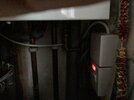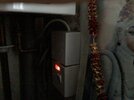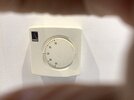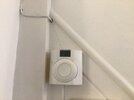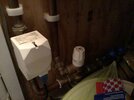In the main central heating is controlled by TRV and actuators the latter in turn controlled by wall thermostats, however if the TRV's are not linked then often there is also a wall thermostat to stop boiler cycling in warm weather, as TRV's can't turn boiler on/off only up/down or once at minimum it will start to cycle on/off but it can't turn boiler fully off.
Where there is UFH there is often a wiring centre
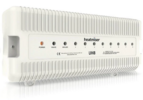
unlike the wiring centres for non UFH these often have a series of relays, and are quite complex
see here to see a bit more however it does not need to be so complex, and I have seen the the UFH part is feed from the radiator return, however in the main the UFH has to be controlled in such a way that the floor can't exceed 27ºC so there is a manifold
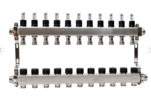
and a second pump
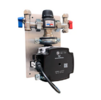
and what happens is the water in the UFH is circulated and as it drops to under 27ºC more central heating water is added.
However with heat pumps the whole idea is never to heat the water that hot to start with, so there are a host of different systems, these are normally installed by a heating and ventilation engineer, the term engineer infers the guy is educated to over level 3, called higher education, HNC, HND, Degree etc. The systems design is over the normal expected from an electrician or plumber, although once designed an electrician or plumber may install them.
The same applies to things like solar panels, you may never see the design guy, he may well never leave the office and his drawing board, but he works out how it is all controlled, and the guys on site do as they are told.
Of course that does not mean all heating installers are university educated, there has been UFH for some time, the Hypocaust system was used by the Romans.
I know when house hunting I was very aware of the problems with DIY UFH, in the main lack of insulation under the heating pipes/mat, and I rejected some houses viewed due to lack of info on who had fitted it and how. I did in a way feel sorry for the sellers as they seemed to think UFH was a selling point, where in fact the reverse was the case.
I have looked at the pictures you have posted, and it does not tell me a thing, and not sure pictures ever would, I remember trying to get my mothers CH to work as it should, my own house worked well, but as I looked at my mothers house I realised hers was very different, main thing she had doors between down stairs rooms, where my house at the time was open plan, I did work it out in the end, it was down to setting the lock shield valves in the main, but the main problem was speed, the radiator was heating up too fast for the TRV to regulate it, and it was over shooting as a result.
We see pictures of how the heat goes into a room
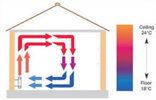
but with UFH that clearly does not happen, so the idea of having the wall thermostat on opposite wall to radiator, or slightly to one side and near bottom of radiator (the TRV) does not work, this is why the heating and ventilation engineer have to spend so long learning their profession, it is beyond the skills required for a trade.


